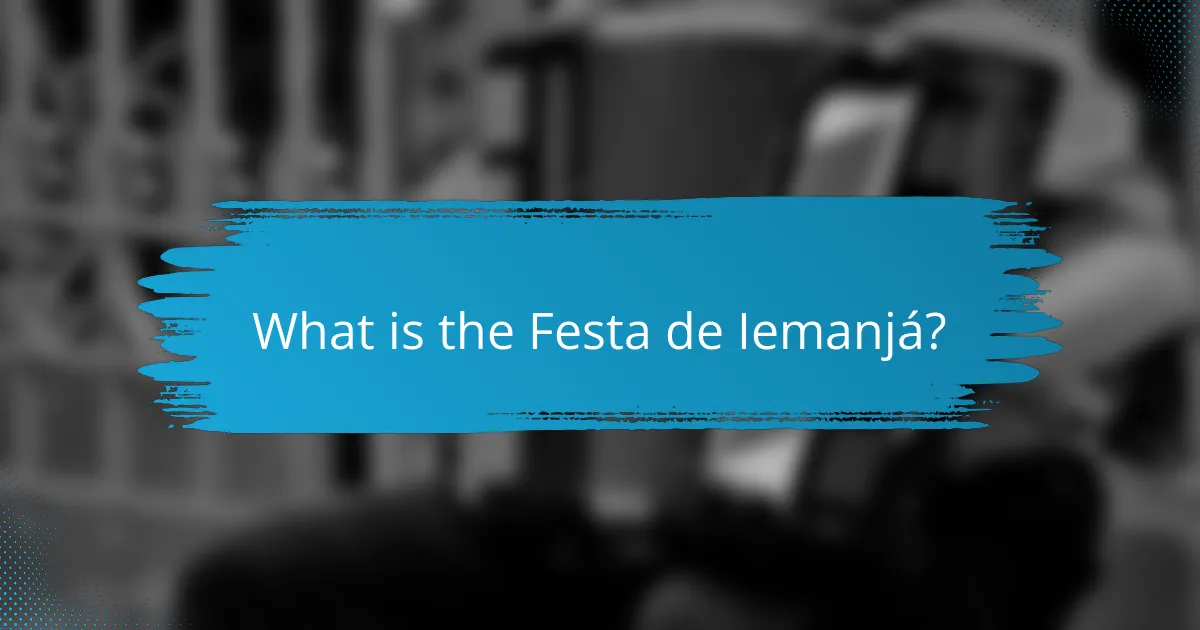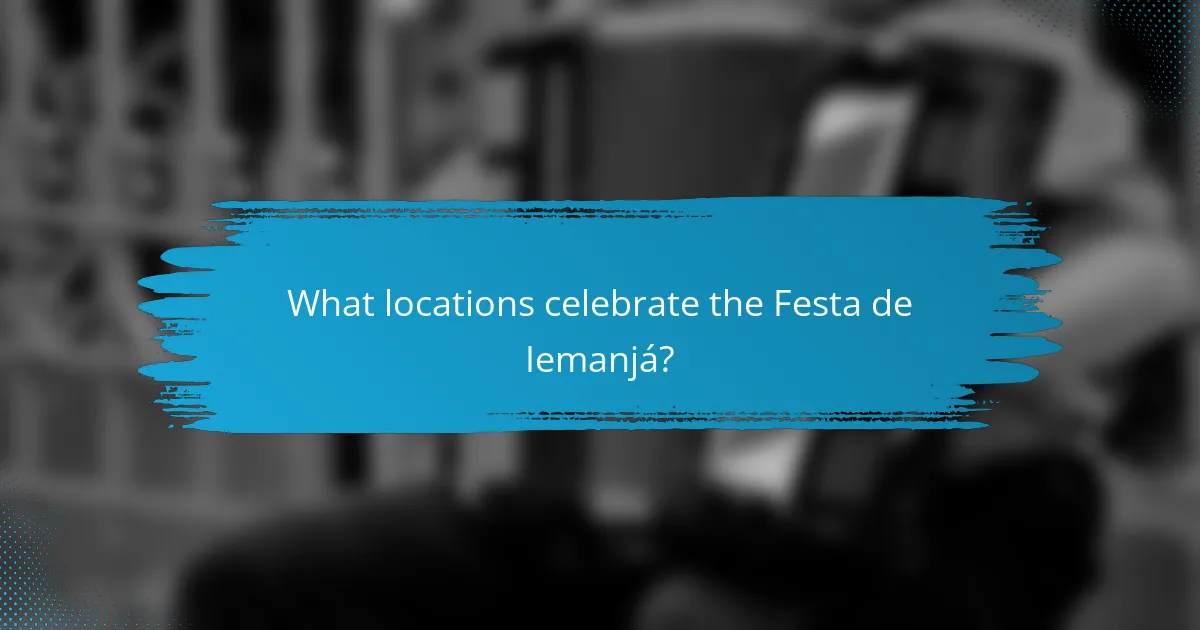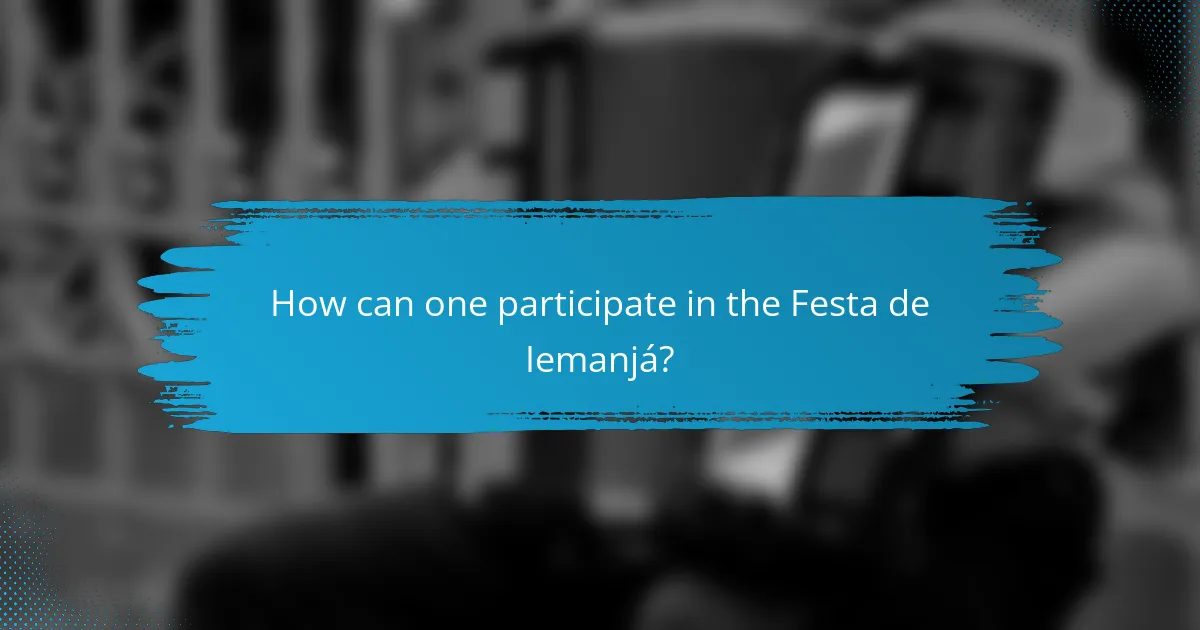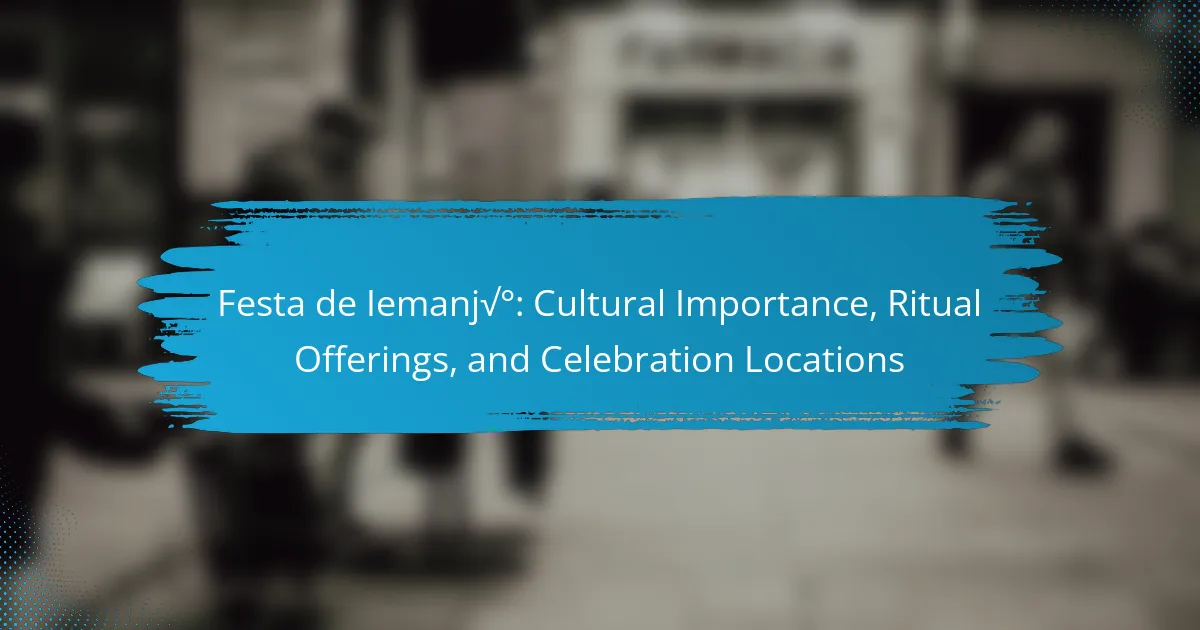The Festa de Iemanjá is a prominent cultural festival in Brazil, celebrated annually on February 2nd in honor of Iemanjá, the Afro-Brazilian goddess of the sea. This festival is particularly significant in coastal cities such as Salvador and Rio de Janeiro, where thousands gather to participate in vibrant processions, music, and dance. Attendees offer flowers, food, and other gifts to seek Iemanjá’s blessings and protection. The event reflects the fusion of African traditions and Brazilian culture, emphasizing its importance in the nation’s cultural heritage. Various locations along Brazil’s coastline also engage in local festivities, showcasing diverse customs and rituals associated with the celebration.

What is the Festa de Iemanjá?
The Festa de Iemanjá is a cultural festival celebrated in honor of the Afro-Brazilian goddess of the sea. It occurs annually on February 2nd, primarily in coastal cities like Salvador and Rio de Janeiro. Participants offer flowers, food, and other gifts to Iemanjá, seeking her blessings and protection. The festival includes music, dance, and vibrant processions along the beach. It draws thousands of attendees, showcasing Brazil’s rich cultural heritage. The event has roots in African traditions and symbolizes the fusion of various cultural influences in Brazil.
How did the Festa de Iemanjá originate?
The Festa de Iemanjá originated from Afro-Brazilian religious traditions. It honors Iemanjá, the goddess of the sea in Candomblé and Umbanda. The festival began in the early 20th century in Salvador, Bahia. It was influenced by African customs brought by enslaved people. The celebration includes offerings to the sea, symbolizing respect and gratitude. Participants often throw flowers and gifts into the ocean. The event has grown into a significant cultural celebration in Brazil. Today, it attracts thousands of devotees and tourists each year.
What historical events led to the celebration of the Festa de Iemanjá?
The Festa de Iemanjá is celebrated primarily due to the African diaspora and the influence of Candomblé in Brazil. This festival honors Iemanjá, the African goddess of the sea. The roots of the celebration trace back to the arrival of enslaved Africans in Brazil in the 16th century. These individuals brought their spiritual beliefs and deities, including Iemanjá.
In the early 20th century, the festival began to gain prominence in Rio de Janeiro. It became a public celebration, blending African and Brazilian cultural elements. The first organized celebrations occurred in the 1920s, attracting larger crowds each year.
By the 1930s, the festival was recognized as an important cultural event. It symbolized resistance and resilience against oppression. Today, the Festa de Iemanjá is celebrated on February 2nd, drawing thousands of participants annually. This historical context highlights the festival’s significance in preserving Afro-Brazilian heritage.
What cultural influences shaped the Festa de Iemanjá?
The Festa de Iemanjá is shaped by African, Indigenous, and Portuguese cultural influences. African traditions, particularly from the Yoruba religion, play a significant role. Iemanjá is a prominent deity in Candomblé, embodying the spirit of the sea and motherhood. Indigenous beliefs contribute elements of nature worship and respect for water. Portuguese culture introduced elements of Catholicism, merging Iemanjá with the Virgin Mary in some celebrations. This syncretism reflects Brazil’s diverse cultural landscape. The festival, celebrated on February 2nd, attracts thousands of devotees. Rituals include offerings of flowers, food, and symbolic objects to honor Iemanjá. These practices highlight the blending of different cultural heritages in Brazilian society.
Why is the Festa de Iemanjá culturally significant?
The Festa de Iemanjá is culturally significant as it honors the Afro-Brazilian goddess of the sea. This celebration reflects the rich heritage of Afro-Brazilian [censured]. It takes place annually on February 2nd, attracting thousands of devotees. Participants offer flowers, gifts, and food to Iemanjá, symbolizing gratitude and reverence. The event fosters community bonding and cultural identity among participants. It also promotes the preservation of African traditions in Brazil. The festival has been recognized as an important cultural event by organizations like UNESCO. Its significance is evident in the vibrant displays of music, dance, and art associated with the celebration.
What role does the Festa de Iemanjá play in Afro-Brazilian culture?
The Festa de Iemanjá is a significant celebration in Afro-Brazilian culture. It honors Iemanjá, the goddess of the sea and motherhood in Candomblé and Umbanda religions. The festival occurs annually on February 2nd, particularly in Salvador, Bahia. Participants offer flowers, perfumes, and other gifts to the goddess, symbolizing gratitude and reverence. This event fosters community bonding among practitioners and showcases Afro-Brazilian heritage. The celebration also highlights the intersection of [censured] and cultural identity. Moreover, it attracts tourists, promoting awareness of Afro-Brazilian traditions. The festival’s rituals and performances reflect the rich cultural tapestry of Brazil.
How does the festival reflect the beliefs and values of its participants?
The Festa de Iemanjá reflects the beliefs and values of its participants through communal worship and cultural expression. Participants honor Iemanjá, the goddess of the sea, showcasing their deep spiritual connection to nature and ancestry. Ritual offerings, such as flowers and gifts, symbolize gratitude and respect for the goddess. This act of giving demonstrates the value placed on reciprocity in the spiritual realm. The festival also promotes unity and solidarity among diverse communities. Participants engage in music, dance, and traditional attire, reinforcing cultural identity and heritage. The vibrant celebration highlights the importance of collective memory and shared beliefs. Historical significance is evident as the festival has been celebrated for decades, illustrating its enduring relevance in contemporary society.
What are the key rituals associated with the Festa de Iemanjá?
The key rituals associated with the Festa de Iemanjá include offerings, processions, and prayers. Offerings typically consist of flowers, perfumes, and food placed in the ocean. Participants often dress in white to honor the goddess Iemanjá. Processions to the beach are common, where devotees sing and dance. Prayers for protection and blessings are integral to the rituals. The festival occurs annually on February 2nd, drawing thousands of participants. This celebration is particularly prominent in Brazil, reflecting cultural heritage and reverence for the sea.
What types of offerings are made during the festival?
During the Festa de Iemanjá, offerings include flowers, candles, and food. Participants often present these items to honor the goddess of the sea. Common food offerings consist of fruits, sweets, and fish. Many also include handmade crafts and jewelry. These offerings are placed on boats or at the water’s edge. The act symbolizes respect and gratitude towards Iemanjá. This tradition reflects cultural beliefs surrounding the goddess. It is an integral part of the festival’s rituals.
How do participants prepare for the rituals of the Festa de Iemanjá?
Participants prepare for the rituals of the Festa de Iemanjá by gathering offerings. Common offerings include flowers, perfumes, and food. They often create elaborate arrangements to honor the goddess. Many participants dress in white clothing, symbolizing purity. Some individuals also make special prayers or requests to Iemanjá. Rituals may involve cleansing practices, such as bathing in the ocean. Participants often gather at specific locations, like beaches, to perform the rituals. Preparation can begin days in advance, reflecting the significance of the event.

What locations celebrate the Festa de Iemanjá?
The Festa de Iemanjá is celebrated in various locations, primarily in Brazil. Notable cities include Salvador, Bahia, where large crowds gather at the beach. Rio de Janeiro also hosts significant celebrations along its coastal areas. Additionally, smaller towns along Brazil’s coastline participate in local festivities. In these locations, offerings are made to Iemanjá, the goddess of the sea. The celebrations often include music, dance, and vibrant processions. Historical records indicate that the festival has roots in African traditions brought to Brazil by enslaved people. This cultural event attracts thousands of participants each year, emphasizing its importance in Brazilian culture.
Where are the most prominent celebrations of the Festa de Iemanjá held?
The most prominent celebrations of the Festa de Iemanjá are held in Brazil. Specifically, the largest events take place in Salvador, Bahia. This city is known for its vibrant cultural heritage and strong Afro-Brazilian traditions. Celebrations also occur in Rio de Janeiro, where many devotees gather at the beaches. These locations attract thousands of participants each year. The festival typically takes place on February 2nd. It honors Iemanjá, the goddess of the sea in Afro-Brazilian religions. Participants offer gifts such as flowers and food to the sea. These celebrations are marked by music, dance, and religious rituals.
What makes Salvador, Bahia a central hub for the festival?
Salvador, Bahia is a central hub for the Festa de Iemanjá due to its rich Afro-Brazilian cultural heritage. The city is home to a significant population of descendants from African slaves, preserving traditions linked to African deities. Salvador hosts the largest celebrations for Iemanjá, attracting thousands of devotees each year. The festival occurs annually on February 2nd, showcasing vibrant processions and offerings to the goddess of the sea. Local customs include the preparation of elaborate floral offerings placed in the ocean. Salvador’s historic neighborhoods serve as key locations for rituals and festivities. The city’s music, dance, and art reflect the deep-rooted connections to African culture. This unique cultural landscape makes Salvador an essential destination for the festival.
How do other regions in Brazil celebrate the Festa de Iemanjá?
In Brazil, regions such as Bahia and Rio de Janeiro celebrate the Festa de Iemanjá with unique traditions. In Bahia, vibrant parades feature offerings of flowers and gifts to the sea. Participants often wear white clothing symbolizing purity. In Rio de Janeiro, celebrations include large gatherings on the beach. People set up altars and release boats adorned with offerings into the ocean. Each region emphasizes music and dance as part of the festivities. The event typically occurs on February 2nd, honoring the goddess of the sea. These practices reflect local cultural expressions and community unity.
What variations exist in the celebration of the Festa de Iemanjá across different locations?
Variations in the celebration of the Festa de Iemanjá occur in different locations. In Bahia, Brazil, the festival features large processions to the sea. Participants often wear white and offer flowers and gifts to the goddess. In Rio de Janeiro, celebrations include music, dance, and elaborate floats. The focus is on community gatherings along the beaches. In Salvador, the event is marked by traditional Candomblé rituals and offerings. Each location reflects local cultural influences and traditions. The date of celebration may also vary slightly, with some regions observing it on February 2nd, while others may have additional local festivities. This diversity showcases the adaptability of the festival across Brazilian culture.
How do local customs influence the way the festival is celebrated?
Local customs significantly shape the celebration of the Festa de Iemanjá. These customs dictate the types of offerings presented to Iemanjá, such as flowers, perfumes, and food. Regional practices influence the music and dance styles featured during the festival. In some areas, traditional Afro-Brazilian rhythms are predominant, while in others, local folk music may take precedence. Community gatherings reflect local social structures and traditions, fostering a sense of belonging. Rituals may vary, with some communities emphasizing specific prayers or chants unique to their heritage. These variations highlight the festival’s adaptability and the importance of local identity. Ultimately, local customs enrich the festival, making each celebration a unique expression of cultural heritage.
What unique practices can be found in different regions during the festival?
Unique practices during the Festa de Iemanjá vary by region. In Bahia, devotees offer flowers and food to the sea. This is done to honor the goddess of the sea. In Rio de Janeiro, large processions take place along the beaches. Participants often dress in white, symbolizing purity and respect. In some coastal towns, boats are decorated and launched into the water. This act represents a tribute to Iemanjá. In other areas, traditional music and dance are integral to the celebrations. Each region’s practices reflect local culture and beliefs surrounding the festival.

How can one participate in the Festa de Iemanjá?
To participate in the Festa de Iemanjá, individuals can attend the celebrations held on February 2nd. Many people visit beaches, particularly in Brazil, to honor Iemanjá, the goddess of the sea. Participants often bring offerings such as flowers, candles, and food. These offerings are placed in the water as a tribute. Traditional music and dance are common during the festivities. Engaging in communal gatherings enhances the experience. Observing rituals and ceremonies adds to the cultural significance. Local customs may vary, so it’s beneficial to learn about specific practices in different regions.
What are the best practices for attending the Festa de Iemanjá?
To attend the Festa de Iemanjá, participate respectfully in the rituals and festivities. Arrive early to secure a good spot for viewing ceremonies. Dress in white, as this color symbolizes purity and respect for Iemanjá. Bring offerings such as flowers, fruits, and candles to honor the goddess. Respect the local customs and traditions during the celebration. Engage with the community and learn about their practices. Avoid littering and help maintain the cleanliness of the area. Be mindful of the ocean’s conditions, as safety is paramount during the event. These practices enhance the experience and show reverence for Iemanjá.
How should participants prepare for the rituals and celebrations?
Participants should prepare for the rituals and celebrations by gathering offerings for Iemanjá. Common offerings include flowers, perfumes, and food items. Participants should also wear white clothing to symbolize purity and respect. It is important to arrive early to secure a good spot for the rituals. Participants should familiarize themselves with the specific customs and prayers associated with Iemanjá. Engaging in personal reflection or meditation can enhance the experience. Hydration and sun protection are essential for outdoor celebrations. Lastly, participants should respect the traditions and other attendees during the festivities.
What etiquette should be observed during the Festa de Iemanjá?
During the Festa de Iemanjá, respectful behavior is essential. Attendees should dress modestly, often in white or light colors, to honor the goddess. Offerings must be placed gently in the water, avoiding any disturbance. Participants should refrain from loud noises or disruptive actions. It is customary to show gratitude after making offerings. People often chant or sing traditional songs to connect spiritually. Observing these etiquettes fosters a respectful atmosphere for the celebration. Following these practices enhances the communal experience and honors Iemanjá’s significance in Afro-Brazilian culture.
What tips can enhance the experience of the Festa de Iemanjá?
To enhance the experience of the Festa de Iemanjá, participants should engage in traditional rituals. Arriving early allows for a better spot to witness the festivities. Dressing in white is customary and symbolizes purity. Bringing offerings like flowers, perfumes, and food is essential for honoring Iemanjá. Participating in the communal dances fosters a sense of community. Attending local events and music performances enriches the cultural experience. Respecting the ocean and the environment is crucial during the celebration. Lastly, connecting with local practitioners can provide deeper insights into the rituals and traditions.
How can one respectfully engage with the cultural aspects of the festival?
To respectfully engage with the cultural aspects of the Festa de Iemanjá, individuals should first educate themselves about the festival’s significance. Understanding the history and traditions surrounding Iemanjá is essential. Participating in rituals with genuine respect enhances the experience. Observing local customs and practices shows appreciation for the culture. It is important to dress appropriately, reflecting the festival’s values. Engaging with community members fosters connection and respect. Offering gifts, such as flowers or food, should align with tradition. Lastly, listening and learning from those who celebrate the festival enriches understanding and respect.
What should attendees know to ensure a meaningful participation in the festivities?
Attendees should know the cultural significance of Iemanjá to participate meaningfully in the festivities. Iemanjá is the Afro-Brazilian goddess of the sea, symbolizing fertility and motherhood. Understanding her importance enhances the experience of rituals and offerings. Attendees should also be aware of traditional practices, such as offering flowers, perfumes, and food to the goddess. Participation in music and dance is encouraged, as it fosters community spirit. Familiarity with local customs and etiquette is essential for respectful engagement. Being present and open to the spiritual atmosphere enriches the overall experience. These elements contribute to a deeper connection with the celebration and its cultural roots.
Festa de Iemanjá is a significant cultural festival honoring the Afro-Brazilian goddess of the sea, celebrated annually on February 2nd, primarily in coastal cities like Salvador and Rio de Janeiro. The festival features rituals such as offering flowers, food, and gifts to Iemanjá, along with vibrant music, dance, and processions that highlight Brazil’s rich cultural heritage. Originating from Afro-Brazilian religious traditions, the event reflects a fusion of African, Indigenous, and Portuguese influences, symbolizing community bonding and the preservation of cultural identity. Key rituals and local customs vary across regions, emphasizing the festival’s adaptability and cultural significance.
